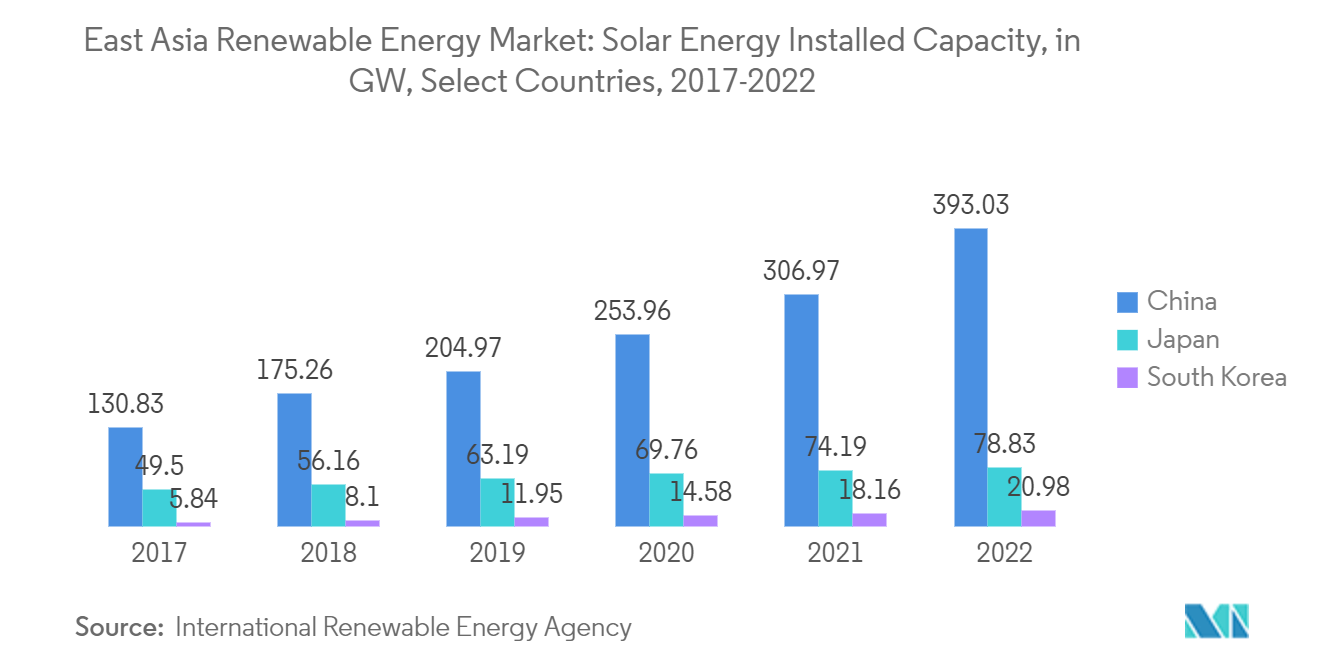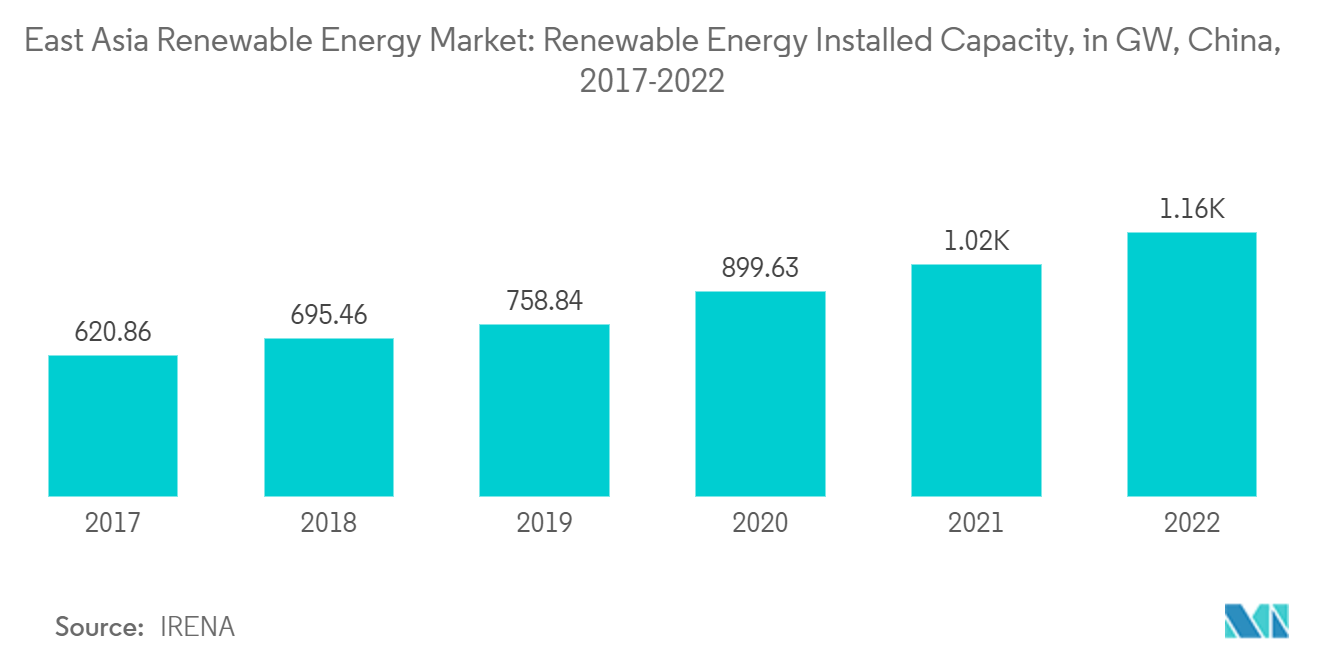Market Trends of East Asia Renewable Energy Industry
Solar Energy to Dominate the Market
- China is the largest solar energy market globally, and the country is expected to retain its top position during the forecast period. According to China's National Energy Administration (NEA), the country expects to install nearly 108 GW of new PV installations in 2022. Solar energy is an integral part of China's renewable energy strategy, and being a manufacturing hub for solar equipment, the country has been rapidly adding solar capacity across all end-user segments.
- Japan has the third-highest installed solar capacity in the Asia-Pacific region. However, due to high solar penetration and low availability of land due to a high population density and its natural island geography, the development and growth of the utility-scale solar segment have been curtailed. Additionally, grid congestion has also contributed to instability and utility layers not being able to sell electricity to consumers. Moreover, it is difficult to secure permits for a solar park above 40 MW in size in Japan as there is a long approval process, which comes on top of high land costs and grid congestion.
- Due to this, most of Japan's installed solar power comes from the residential and commercial sectors, which utilize rooftops instead of land. According to IRENA, as of 2022, Japan had nearly 78.83 GW of solar power. However, according to METI, as of FY 2022, Japan had nearly 4080 utility-scale solar power plants with a net combined capacity of 14.85 GW.
- Due to such factors, land-constrained Japan has been building a larger number of utility-scale solar projects in mountainous areas. For instance, in November 2021, a 37 MW solar plant was commissioned in Kawakami, a village located at an altitude of 1,185 meters in Japan's Nagano prefecture. Japan has shown robust growth in solar energy installed capacity. The country's installed solar energy capacity reached 61 GW in 2019, up from 28 GW in 2015.
- South Korea is one of the largest solar energy markets in the Asia-Pacific region. According to the Korea Energy Agency, as of 2021, the country had a total installed solar capacity of nearly 22 GW, with nearly 4.4 GW of new capacity installed in 2021. The country is also making significant investments in utility-scale solar. For instance, in July 2022, construction began on a 200 MW solar farm at a former salt farm in Sinan country, South Jeolla province.
- Additionally, the country has a significant solar manufacturing sector, which is expected to reduce supply chain costs further. Additionally, the country is expected to relax solar permitting regulations to achieve its target of reducing emissions by 40% by 2030.
- With growing electricity generation from solar in countries like China and Japan, solar energy is expected to dominate the renewable energy market in the East Asia region in the forecast period.

China to Dominate the Market
- China is the largest renewable energy market in the world and has been driving the renewable energy market in East Asia, with an installed capacity of 1160.79 GW in 2022. With several large upcoming projects and ambitious targets, China is expected to dominate the market in the forecast period.
- According to the China Energy Portal, during 2014-2021, China's total installed wind capacity registered a CAGR of 15.71%. As part of its 14th five-year plan (2021-2025), the country aims to contribute 33% to national power consumption by 2025 and for non-hydro renewables to contribute 18%. Additionally, the country also aims to increase renewable energy generation to 3,300 TWh by 2030.
- China is investing heavily in the development of gigantic energy hubs that can supply energy to China's energy-hungry economy. In March 2022, the Chinese government announced plans to build 450 GW of solar and wind power generation capacity in the Gobi and other desert regions, with nearly 100 GW of solar power capacity already under construction. This is in line with China's aim of building 1200 GW of wind and solar capacity by 2030.
- In its 14th five-year plan passed in 2021, China introduced the concept of "clean energy bases." These are large areas designated for the simultaneous construction of several GW-scale large wind and solar parks, connected to demand centers via high-capacity long-distance transmission lines.
- Most of these clean energy bases are concentrated in the sparsely populated western provinces. China has nearly 2.6 million square kilometers of desertified land, accounting for 25% of its landmass. Additionally, massive tracts of land have been turned into wasteland due to coal mining and other industrial activities. The Chinese government aims to set up huge clean energy bases in these low-density regions to power the densely populated eastern coastal regions.
- According to government plans, the country has a target of installing 555 GW of wind and solar capacity by 2030, which is divided into two lists.
- The projects on the first list have a cumulative capacity of 97 GW across 19 provinces, with 43 GW situated in the Gobi and other desert regions in north and northwest China. In 2021, construction started on projects with a cumulative capacity of 75 GW.
- The government intends to add 300 GW of clean energy by 2025 and then 255 GW of clean energy by 2030 to the second list. The projects on this list are primarily concentrated in the Kubuqi, Ulan Buhe, Tengger, and Badain Jaran deserts, with a combined capacity of 284 GW. An additional 134 GW is planned in other desert regions, while 37 GW is expected to be built in areas that have subsided due to coal mining.
- Hence, with rapidly growing power demand and parallel energy policies, China is expected to dominate the renewable energy market in East Asia during the forecast period.

